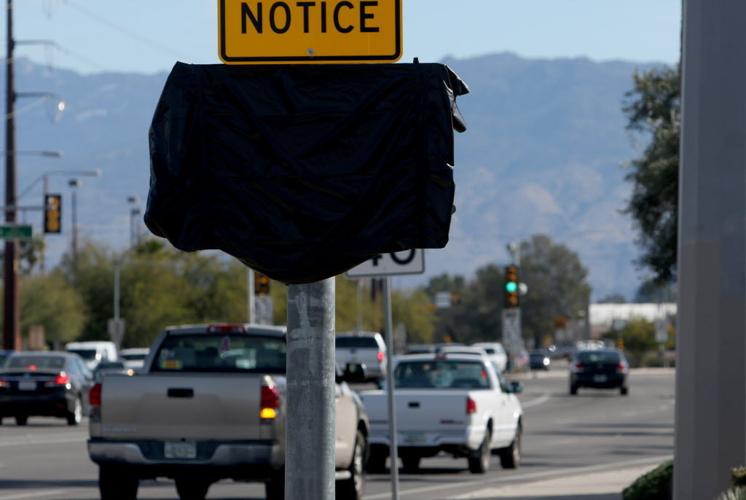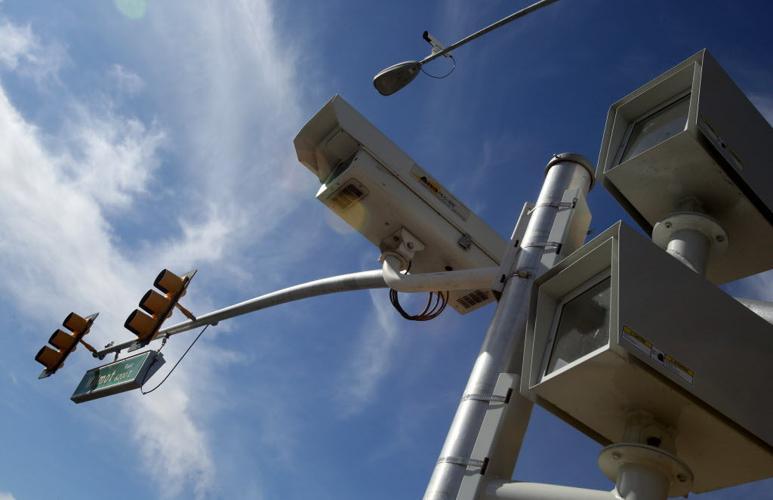Red light cameras. Photo radar enforcement. Automated traffic safety systems.
Whatever you call it, Tucson voters said loud and clear in November they don’t want them.
So why are the cameras still in place at intersections throughout the city two months later?
Lots of readers have been asking that, so Road Runner put the question to the city.
According to the city Transportation Department, the cameras are no longer active, and in some of the locations have been removed from their cases.
Essentially, what remains at the eight city intersections that had photo traffic enforcement are empty boxes and a few flashbulbs.
Once all the internal mechanisms are removed, the lights and stands will come down. So that means we can say goodbye to government authorities monitoring us remotely through cameras, right?
Maybe not.
A bill proposed in the Legislature would allow school districts, in cooperation with local law enforcement, to install cameras on buses to record and ticket drivers who pass a stopped school bus letting out or picking up children.
“It’s only about money,” said Mark Spear, one of the people behind the successful campaign to ban photo speed enforcement in the city.
Not only would HB 2366 allow private operators to profit from traffic enforcement, it would eliminate requirements to prove who was driving the car.
The way photo enforcement worked in the city before voters put a stop to it was that the cameras took photos of license plates and drivers, which were reviewed by law enforcement and checked with MVD records to identify the driver.
Tickets were then mailed to the car owners, who most of the time ignored them, requiring a process-server to attempt to deliver legal papers in person.
Under the current proposal, only a photo of the license plate would be taken, with the ticket mailed to the car’s owner. There would be no obligation to identify the driver.
“It takes away your requirement to be served in person,” Spear said.
The bill also redefines all forms of photo enforcement as an “automated traffic safety device.”
And the law would exempt public-safety vehicles from citations. This would be understandable if the bill exempted those officials who are responding to a an emergency, but it doesn’t.
Instead, it reads: “A motor vehicle in use by a first responder in the line of duty is exempt from any enforcement action or measure resulting from an automated traffic safety device.”
In the line of duty seems a rather broad term that could mean any time a public-safety worker is on the clock and driving a car.
Spear said he suspects the bill will soon be pulled by its sponsors, if it hasn’t been already. Even if it is, don’t count on that being the last you hear about automated traffic safety.
The companies in this industry have taken hits to their business models over the years as communities like Tucson ban remote ticketing.
As that occurs, the companies will continue to try to find ways to get back in the game and keep making money.
Down the road
Century Link is continuing work to relocate existing facilities as the city of Tucson Department of Transportation’s Downtown Links Phase III project moves forward.
On Monday, Jan. 25, from 11 p.m. to 5 a.m. Tuesday, Jan. 26; and from 11 p.m. to 5 a.m. Wednesday morning, the northbound and southbound travel lanes on Sixth Avenue between Seventh Street and Sixth Street will be closed.
The closure will allow Century Link crews to use a crane to install a utility vault at the construction site.
Also on Monday, TDOT will begin installing Optical Vehicle Detection (OVD) cameras at 12 intersections. Work hours will be 6:30 a.m. to 4:30 p.m. Monday through Thursday. Plan for lane restrictions between 9 a.m. and 3 p.m.
From Jan. 25 to Feb. 4, the cameras will be installed at the following intersections: 44th Street and 16th Avenue; Ajo Way and Sixth Avenue; Speedway and Country Club Road; Grant Road and Mountain Avenue; Limberlost Road and Oracle Road; St. Mary’s Road and Anklam Road; Valencia Road and Santa Clara Avenue; and Los Reales Road and Nogales Highway.
The cameras are used to detect the presence of vehicles at an intersection to provide the best distribution of green-light time, based on traffic volumes.






